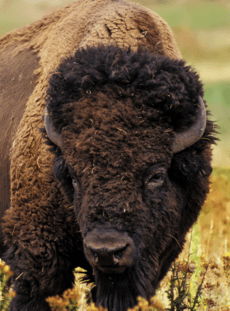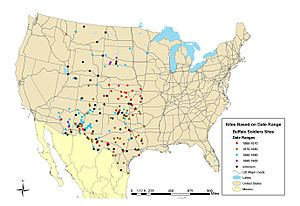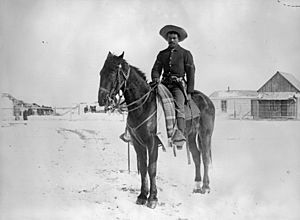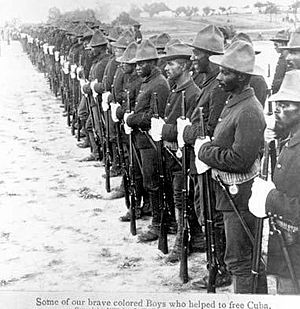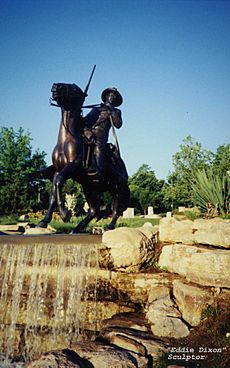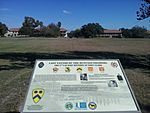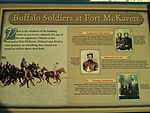Buffalo Soldier facts for kids
Quick facts for kids Buffalo Soldiers |
|
|---|---|
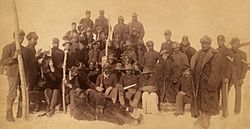
Buffalo Soldiers of the 25th Infantry Regiment in 1890
|
|
| Active | 1866–1951 |
| Country | |
| Branch | 9th Cavalry Regiment |
| Nickname(s) | "Buffalo Soldiers" |
| Colors | Blue |
| Engagements | American Indian Wars Spanish–American War Philippine–American War Mexican Border War World War I World War II |
The Buffalo Soldiers were brave African-American soldiers in the United States Army. They were first formed on September 21, 1866, at Fort Leavenworth, Kansas. Native American tribes gave them this nickname during the American Indian Wars.
The name "Buffalo Soldiers" eventually came to mean all the African-American regiments created in 1866. These included:
While some African-American groups fought in the American Civil War, the Buffalo Soldiers were the first all-black regiments formed in the regular U.S. Army during peacetime. On September 6, 2005, Mark Matthews, the oldest surviving Buffalo Soldier, passed away at 111 years old. He was laid to rest at Arlington National Cemetery.
| Top - 0-9 A B C D E F G H I J K L M N O P Q R S T U V W X Y Z |
Who Were the Buffalo Soldiers?
During the Civil War, the U.S. government created units called the United States Colored Troops. These groups included black soldiers and Native Americans. After the war, these units were disbanded in 1865.
In 1867, the U.S. Army decided to create new regiments. They were allowed to form two regiments of black cavalry and four regiments of black infantry. Many of these new soldiers were veterans from the earlier Colored Troops.
In 1869, the Army was reorganized. The black infantry was reduced to two regiments: the 24th and 25th (Colored) Infantry. The two black infantry regiments made up 10% of all infantry. The two black cavalry units made up 20% of all cavalry.
These early black regiments had white officers leading them. However, they also had black non-commissioned officers. In 1877, Henry Ossian Flipper became the first black officer to lead Buffalo Soldiers. He was also the first black graduate of West Point.
What Did the Buffalo Soldiers Do?
Fighting in the Indian Wars
From 1866 to the early 1890s, Buffalo Soldiers served in the Southwestern U.S. and the Great Plains. They fought in many military campaigns during the American Indian Wars. They earned a strong reputation for their bravery.
Nineteen soldiers and officers from these regiments received the Medal of Honor during these wars. Besides fighting, Buffalo Soldiers also built roads and protected the U.S. mail. They helped keep peace and order on the frontier.
For example, the 9th Cavalry guarded the Pine Ridge Indian Reservation during the Ghost Dance War. They also helped remove settlers from Native American lands. In total, 23 Buffalo Soldiers earned the Medal of Honor during the Indian Wars.
The Johnson County War
The 9th Cavalry also played a part in the Johnson County War in Wyoming in 1892. This was a conflict between small farmers and large ranchers over land. The 6th Cavalry was first sent to stop the fighting.
However, the 9th Cavalry was specifically asked to take over. They arrived quickly from Nebraska and set up "Camp Bettens". Even though some locals were hostile, the 9th Cavalry stayed for almost a year. They helped calm the tensions in the area.
Serving in Other Wars (1898–1918)
After the Indian Wars, the Buffalo Soldiers continued to serve. They fought in the Spanish–American War in 1898 in Cuba. Five more Medals of Honor were earned during this war.
Buffalo Soldiers were the only African Americans who fought in Cuba during this war. Other African-American volunteer regiments were formed, but only one served overseas.
The Buffalo Soldiers also fought in the Philippine–American War (1899–1903). They also took part in the Pancho Villa Expedition in Mexico in 1916. In 1918, the 10th Cavalry fought in the Battle of Ambos Nogales during World War I. They helped force Mexican forces to surrender.
Buffalo Soldiers were also involved in the last battle of the Indian Wars. This was the small Battle of Bear Valley in Arizona in 1918.
Buffalo Soldiers as Park Rangers
A lesser-known role of the Buffalo Soldiers was serving as some of the first national park rangers. In 1899, soldiers from the 9th Cavalry and 24th Infantry served in California's Sierra Nevada parks. These included Yosemite National Park, Sequoia National Park, and Kings Canyon National Park.
Before 1899, only white soldiers served as park rangers. From 1899 onwards, African-American regiments served in Sequoia and Yosemite during the summers. They were "park rangers" before the official National Park Service was created in 1916.
The famous Ranger hat (or Smokey Bear hat) may have been influenced by the Buffalo Soldiers. They wore a distinctive "Montana peak" crease in their hats. This style helped shed water during heavy rains in the Spanish–American War.
One important Buffalo Soldier was Captain Charles Young. He served in Sequoia National Park in 1903. He was the third African American to graduate from West Point. He became the first African American superintendent of a national park.
In 1903, 9th Cavalrymen in Sequoia built the first trail to the top of Mount Whitney. This is the highest mountain in the connected United States. They also built the first wagon road into Sequoia's Giant Forest.
In 1904, 9th Cavalrymen in Yosemite built an arboretum. This was a garden with pathways and benches, where plants were identified. It is considered the first museum in the National Park System.
The Buffalo Soldiers protected national parks from illegal grazing, poaching, timber thieves, and forest fires. They often faced long days, little food, and racism.
West Point Connection
In 1907, the West Point changed its cavalry detachment to a "colored" unit. This meant that black non-commissioned officers from the 9th and 10th Cavalry taught future officers how to ride horses and perform drills. They were considered the best at these skills.
This 100-man detachment taught at West Point until 1947. In 1931, the 10th Cavalry's "Escort of Honour" detachment was the last regular army unit to wear the M1902 blue dress uniform.
Facing Challenges: Prejudice
Buffalo Soldiers often faced racism from other U.S. Army members. Civilians in areas where they were stationed sometimes reacted with violence. There were attacks on Buffalo Soldiers in Rio Grande City, Texas, in 1899, Brownsville, Texas, in 1906, and Houston, in 1917.
During the Indian Wars, Buffalo Soldiers received fewer Medals of Honor compared to their numbers. They made up a large part of the cavalry and infantry. Some historians believe this was due to racism and their remote postings.
General John J. Pershing
General of the Armies John J. Pershing served with the 10th Cavalry Regiment from 1895 to 1897. He learned to respect the black soldiers he led. Later, during the Spanish–American War, the press nicknamed him "Black Jack" because of his time with the 10th Cavalry.
Pershing fought with the 10th Cavalry in Cuba and was recognized for his bravery. However, during World War I, he did not fully support black soldiers fighting on the battlefield. He followed the policies of President Woodrow Wilson and others who supported segregation.
Even so, Pershing allowed African-American soldiers to fight under French command. This was the first time American soldiers fought under a foreign power.
Service in the Mexican Border and World War I
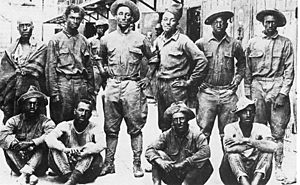
The Mexican Revolution began in 1910. This led to many conflicts along the U.S.–Mexico border. Buffalo Soldier units were sent to the border to keep things safe. They played an important role in U.S.–Mexico relations.
In 1915, the U.S. government recognized Venustiano Carranza as the leader of Mexico. Pancho Villa, who felt betrayed, attacked Columbus, New Mexico. President Woodrow Wilson sent the Punitive Expedition into Mexico to capture Villa. The 9th and 10th regiments of Buffalo Soldiers were part of this mission.
Although Villa was not caught, there were small fights. One notable event was the Battle of Carrizal in 1916, where some Buffalo Soldiers were captured. They were later released. The U.S. focused on World War I instead of continuing the hunt for Villa.
The Buffalo Soldiers did not fight with the main American forces in World War I. However, experienced black non-commissioned officers were sent to other segregated black units for combat. The 92nd and 93rd infantry divisions were among the first Americans to fight in France.
On August 27, 1918, the 10th Cavalry helped in a border fight in Nogales, Arizona, and Nogales, Sonora. This was called the Battle of Ambos Nogales. It was the only time German military advisors were said to have fought alongside Mexican soldiers against U.S. soldiers in North America during World War I.
The presence of Buffalo Soldiers in Nogales had a big impact. The famous jazz musician Charles Mingus was born there in 1922. His father was a Buffalo Soldier. The African-American community in Nogales faced discrimination, including segregated schools.
World War II and Beyond

Before World War II, the 25th Infantry Regiment was based at Fort Huachuca. During the war, this fort became home to the black 92nd and 93rd Infantry Divisions. The 9th and 10th Cavalry Regiments were mostly disbanded. Their soldiers moved into support units.
The 92nd Infantry Division fought in the Italian campaign. The 93rd Infantry Division served in the Pacific. Other black artillery, tank, and support groups also fought. All these units carried on the traditions of the Buffalo Soldiers.
Black airmen, known as the Tuskegee Airmen, also played a brave role in the air war in Europe. In 1945, during the Battle of the Bulge, there was a shortage of combat troops. So, black soldiers were allowed to volunteer for infantry duty. Over 4,500 responded, and their excellent performance helped change how black troops were used in the future.
Korean War and Integration
In 1948, President Harry S. Truman signed Executive Order 9981. This order ended segregation in the military. It was a big step against Jim Crow laws. During the Korean War, black and white troops fought together in integrated units for the first time.
The 24th Infantry Regiment fought in the Korean War. It was the last segregated regiment to see combat. It was deactivated in 1951, and its soldiers joined other integrated units. On December 12, 1951, the last Buffalo Soldier units were disbanded.
Monuments honoring the Buffalo Soldiers can be found in Kansas at Fort Leavenworth and Junction City. Colin Powell, who later became Chairman of the Joint Chiefs of Staff, helped create the Fort Leavenworth monument. He was a brigadier general there and spoke at its unveiling in 1992.
Legacy and Recognition
Historical Markers
Images for kids
-
Sgt. John Harris of the 10th U.S. Cavalry with a Sharps rifle, around 1868.
-
Buffalo Soldiers at the Fort McKavett State Historic Site.
-
Buffalo Soldiers National Museum in Houston.
-
The Richard Allen Cultural Center in Leavenworth, Kansas. It shares the history of African Americans, especially Buffalo Soldiers.
See also
 In Spanish: Soldados Búfalo para niños
In Spanish: Soldados Búfalo para niños


